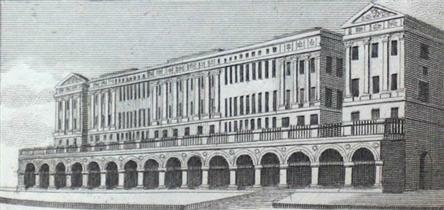The Adam brothers built a very large development including a run of houses with a terrace that overlooked the river, which was much closer before the Embankment was built. It was this terrace that caused the word "terrace" to take on the meaning of a row of houses. Torn down in 1935 and replaced with the art deco New Adelphi building. It was the demolition of the Adelphi that was, at least partially, responsible for the creation of the Georgian Society in 1937.
is a very useful page with excellent images.
While thinking of how London has changed the English language, in the field of architecture at least, let's examine "Mews". From the French, it used to mean a place where hawks (kept for hunting) were confined during their moulting seasons. From 1377 the King's Mews was at Charing Cross, about where Trafalgar Square now is. In 1537 Henry VIII had it converted to be the royal stables. And hence Mews became the term for all service streets in London built as stables, converted into garages and then converted into rather chic homes for fashionable Londoners, such as .
The image on this page shows a front elevation very different from that on our Garrick page. In 1872 the Victorians obliterated the Adams' neoclassical façades, adding heavy decorative features, around the windows and the bulky central attic pediment. The resultant houses would have been unrecognisable to their architects.
Drawings at the Rise and Fall make it clear that the houses at the two ends of the Terrace were detached from the main body of 10 houses. No.11, the detached house at the eastern end, survived not just demolition in the '30s but also the attentions of the Victorians. Google Maps does not provide a good view of it but has a photo, from which one can imagine how impressive the whole Terrace must have been during its first 100 years.
For more information see ''. There is also from Hansard, a splendid speech made by , 16 March 1933. gives all the occupants.









Comments are provided by Facebook, please ensure you are signed in to see them